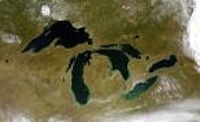Resisting "Rust Belt" reactors' radioactive risks!
 The Great Lakes forms the border between the U.S. and Canada. It serves as the drinking water supply for 40 million people. 20 reactors on located on its Canadian shores, and 13 on its U.S. shoresAs if the closing steel mills and automobile manufacturing plants weren't bad enough, some of the oldest, most risky atomic reactors in the U.S. are located in the Midwest. Worse still, they are on the shores of the Great Lakes, putting at risk the drinking water supply for 40 million people downstream in the U.S., Canada, and a large number of Native American First Nations. Altogether, 33 atomic reactors are located on the shorelines of the Great Lakes.
The Great Lakes forms the border between the U.S. and Canada. It serves as the drinking water supply for 40 million people. 20 reactors on located on its Canadian shores, and 13 on its U.S. shoresAs if the closing steel mills and automobile manufacturing plants weren't bad enough, some of the oldest, most risky atomic reactors in the U.S. are located in the Midwest. Worse still, they are on the shores of the Great Lakes, putting at risk the drinking water supply for 40 million people downstream in the U.S., Canada, and a large number of Native American First Nations. Altogether, 33 atomic reactors are located on the shorelines of the Great Lakes.
Two of the most infamous of these radiologically risky "Rust Belt reactors" are Entergy Nuclear's Palisades in southwest Michigan, and FirstEnergy's Davis-Besse in northwest Ohio.
Last month, U.S. Rep. Ed Markey (D-MA), a long-time watchdog on the nuclear industry, wrote the U.S. Nuclear Regulatory Commission (NRC) about an acidic, radioactive leak representing a "crisis in the control room at the Palisades nuclear power plant." The leakage had been ongoing for a year, and was being "contained" in glorified buckets referred to by Entergy PR spokesman Mark Savage as "catch basins." Although the leak came to light when Palisades was forced to shutdown after its rate reached more than 30 gallons per day, it had been ongoing for months at a rate of 15 gallons per day. The tritiated and borated water is leaking from a 300,000 gallon Safety Injection Refueling Water storage tank, which is safety critical for both reactor core and radiological containment cooling. Whistleblowers contacted Washington, D.C. attorney Billie Pirner Garde, who alerted Rep. Markey, who wrote NRC. The NRC Office of Investigations has launched a probe into potential Entergy wrongdoing. On July 17th, NRC issued a "Confirmatory Action Letter" which enables Palisades to keep operating into 2013, even if the leak increases to nearly 38 gallons per day!
Markey demanded a copy of an internal Entergy report surveying its own workers on "safety culture" at Palisades. Michigan Radio obtained a copy, which reveals "a lack of accountability at all levels," and a workforce deeply distrustful of management, fearful that they will be harassed and punished if they dare to raise safety concerns.
Last February, NRC lowered Palisades' safety status to one of the four worst atomic reactors in the U.S., after a near electrocution of an electrician last September cut power to half the control room, instantly throwing 22 plant systems into chaos, and bringing multiple Palisades' age-degraded structures and components (the reactor has operated since 1971 on the Lake Michigan shore) -- including the most embrittled reactor pressure vessel in the U.S., and steam generators that have needed to be replaced (for the second time in the plant's history) over six years ago -- to the breaking point. More than one pathway to a Loss of Coolant Accident came precariously close to happening, which could have led to meltdown and catastrophic radioactivity release.
Beyond Nuclear's Kevin Kamps will represent Palisades watchdogs at an "Occupy Entergy" gathering at the World Fellowship Center in Conway, New Hampshire this weekend. Watchdogs from numerous Entergy Nuclear reactors across the U.S. will come together to advance shutdown campaigns at Entergy reactors, from Vermont Yankee, FitzPatrick NY, and Pilgrim MA (all General Electric Mark I Boiling Water Reactors, identical twins to Fukushima Daiichi), to pressurized water reactors like Indian Point, NY and Palisades. Beyond Nuclear's Paul and Linda Gunter will help lead the strategic retreat.
At the 35-year-old Davis-Besse atomic reactor near Toledo on the Lake Erie shore, Beyond Nuclear and its environmental coalition allies have pressed their case against a 20 year license extension at one of the most problem-plagued plants in U.S. history. The coalition, represented by attorney Terry Lodge, contends that Davis-Besse's severely cracked and degraded shield building represents a potentially catastrophic radiological risk, which should preclude the 2017 to 2037 license extension.
U.S. Representative Dennis Kucinich (D-OH), whose Cleveland area district is immediately downwind, has been a long-time critic of Davis-Besse. He just wrote an op-ed, "If You Lived Downwind of this Power Plant, Would You Be Concerned?," which first appeared in the Elyria Chronicle Telegram, and has been reprinted at the Huffington Post. Rep. Kucinich has also expressed his solidarity with the 170,000 protestors in Tokyo calling for an end to nuclear power in Japan after the Fukushima Daiichi catastrophe.
Referring to Davis-Besse, Rep. Kucinich said: “The people of Japan, and indeed every country, deserve better than being condemned to repeat such disasters, especially when they demand a sustainable path forward. I stand with them not only because they have a right to be free of the catastrophic health and financial risks that nuclear power clearly brings, but because we share the same risks in my own backyard...We must support the Japanese people, if for no other reason that their nuclear explosions could easily become ours.”
FirstEnergy also owns and operates the Perry nuclear power plant to the northeast of Cleveland, which, along with Palisades, is regarded by NRC as one of the four worst run reactors in the U.S.





 July 19, 2012
July 19, 2012